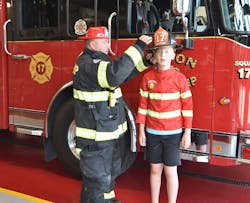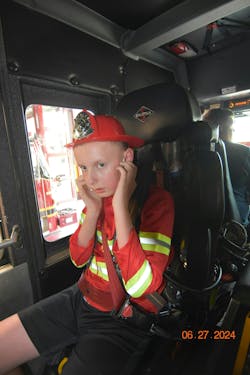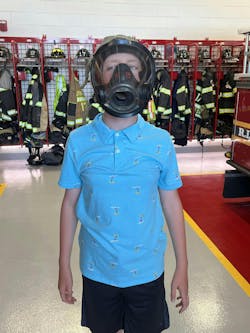Top 5 Firefighter Strategies to Create Safer Encounters for Individuals With Autism Spectrum Disorder
During an emergency, knowing how to approach and communicate with someone with autism spectrum disorder (ASD) is crucial to the safety of both the firefighter and the individual. Being prepared with strategies to help someone with ASD can save lives.
Individuals with ASD and other neurodivergent disorders experience high levels of stress during an emergency, which can increase the severity of the situation. Sensory overload, disruption of routine and unfamiliar social interactions can be very overwhelming.
According to Centers for Disease Control and Prevention, as of June 2024, 1 in 36 individuals in the United States have been identified as having some level of ASD. National Autism Association (NAA) Impact Report (2022) found 71 percent of deaths for individuals with ASD were the result of accidental drowning, and 49 percent of children with autism attempt to wander off, or elope, from a safe environment. A study in Journal of Autism and Development Disorders found 20 percent of youths with ASD were stopped and questioned by police, and nearly 5 percent were arrested. Adults with ASD are just as likely to hide in a fire situation as children do. Firefighters and other first responders must understand the characteristics of ASD and learn strategies to assist them in an emergency. Through proper training, these statistics can be decreased.
ASD falls under the neurodiversity umbrella with other cognitive processing disorders. Individuals with ASD have specific characteristics that are categorized into four main areas: social interaction, social communication, routines and repetitive behaviors, and sensory processing. Through proper training, fighters can identify characteristics of ASD, recognize triggers and adapt the environment for a safer encounter.
Below are five tips that all first responders should use in an emergency that involves someone who has ASD.
1. Look for water first, then ask four questions
People with ASD wander off, which is called eloping, particularly when routines are broken, or such people become overwhelmed. According to NAA, 49 percent of children with ASD attempt to elope from a safe environment. Individuals with ASD commonly are attracted to water for its shiny surface and sensory stimulations. With a limited awareness of danger, individuals with ASD could head toward unfamiliar water without hesitation.
When responding to an eloping call, start by looking for nearby sources of water (pools, lakes, creeks, etc.) to avoid the situation turning into a water rescue. Once nearby water dangers are identified, ask family members the 4 LIFE questions to navigate your search.
L: What does the individual loath? Finding out what an individual with ASD doesn’t like or fears could eliminate where the individual wouldn’t go. For example, if the individual has a fear of dogs, the person might change directions to avoid a house that has a dog in the yard.
I: What are the individual’s interests? The interests and attractions of the individual might lead the person in a specific direction. Most individuals with ASD have intense focused interests in specific items or topics. Use this to your advantage when you interact with or search for someone who has ASD.
F: What fueled the elopement? What just happened that triggered the individual to leave? A change in routine, a meltdown or a new stimulation can trigger a person with ASD to elope. By knowing the trigger, you can possibly decipher when and why the individual eloped.
E: What was the individual’s expectation? What is the individual’s normal routine or what did that person expect to do that day? This helps if the individual was trying to get back on schedule or fulfill an expectation. Was a trip somewhere promised to the individual? What is the person’s normal routine at that particular time? This gives a first responder some possible destinations to search.
Asking these questions can give a first responder insight into where the individual might head. Knowing likes, dislikes and expectations helps to steer the search in a specific direction, which can save time finding the individual. Always remember to know the water locations first.
2. Adapt how you assess injuries because of different pain thresholds
Individuals with ASD can be hypersensitive or hyposensitive to pain and other stimulations. Hypersensitivity causes overreactions to light, sound, touch and pain. Hyposensitivity commonly displays lower tolerance or attraction to the same stimulations. This is vital when considering injuries that were sustained by an individual with ASD. First responders should take into consideration that the individual might not communicate properly any pain or injury that he/she has. Relying on different assessment techniques might be required. For example, complete a full physical examination, rather than relying on pain reactions or the patient’s communication. Also, consider the common injuries that are sustained by similar accidents and assess for those.
3. Reduce sensory overload in emergency situations
Because of the differences in the ability of a person with ASD to mentally register various environmental sensations compared with others, it’s vital that firefighters be aware of sensory overload triggers.
When an individual with ASD is overloaded, that person might elope or hide or have a meltdown. By effecting small changes in the environment, stimulations are reduced, which decreases such an individual’s stress levels. Minimize the lights and sirens. Reduce body contact without permission. When possible, explain where and how you are going to touch the individual. Show the patient what you’re using and let the person touch it first. Walking the individual through the procedure of even putting on a bandage can make the person feel calmer.
When stress is heightened, individuals with ASD tend to flap their arms, spin or rock to deescalate themselves. These movements of self-stimulation are called stimming. Stimming is a response technique to regulate emotions and decrease sensory overload. Stimming looks different for everyone but can be mistaken for spastic movements that are associated with other conditions or for being under the influence of drugs or alcohol.
Expand the personal space of an individual with ASD and avoid restraints if possible. Use of calming techniques and tools, such as fidget toys and stress balls, could reduce the individual’s need for stimming.
4. Consider your communication style when you converse with someone with ASD
Individuals with ASD commonly have difficulty understanding social language.
Figurative language and indirect questions can be difficult to interpret. “Give me your attention” is more ambiguous than “Focus on what I am saying.”
Indirect questions can cause confusion. “Is your mom in the house?” might imply that you, the expert, believe that she is. Instead, ask specific, direct questions: “Can you tell me where your mom is?”
Nonverbal forms of communication are also difficult. Direct, simple, step-by-step descriptions of what’s happening are best. For those who are nonverbal, consider having a symbol board on hand, to use images to communicate. An easy internet search using the term “emergency communication cards” will bring you to free, printable symbol boards to carry in a rig.
5. Find ways to connect to the ASD community
Firehouses should create opportunities to connect with their surrounding community, particularly individuals who have special needs. Knowing the individuals with ASD who live in your community could change how calls come in and how firefighters might respond.
Images of puzzle pieces and rainbow infinity symbols are the most common icons of neurodiversity. Recently, a rainbow butterfly emerged to represent the idea of “hidden disabilities,” which would include those with ASD, mental health disorders and other developmental disabilities that are under the neurodiversity umbrella.
Seeing these symbols on automobiles, shirts and other merchandise can open a dialogue about the individual who lives in your community.
Provide opportunities to educate people with ASD. If you asked people to draw a firefighter, many would grab a red crayon. Children’s books display firefighters in the red hat and coat standing with a dalmatian. The realistic image of a firefighter’s gear is much different. Masks and breathing apparatus can seem scary. Providing opportunities to touch, hear and see the equipment can reduce anxiety prior to an emergency.
Some firehouses recently invited those with ASD to be part of drills. This allows for practice and familiarity before a real emergency occurs. Police and fire departments around the country are creating registries of homes where individuals with ASD live that families can voluntarily join. These registries can’t be mandated, and all must follow HIPAA guidelines.
Be prepared
By equipping them with proper safety tips, firefighters and first responders can tailor the procedures for individuals with ASD effectively. Approaching an emergency with the thought, “Could this be someone with ASD?” would allow time to rethink the approach, try different communication techniques and, possibly, alter the environment, to ensure that those with ASD are safe and receive proper care.
A commitment to understanding the uniqueness of ASD and to training on adaptive procedures not only can improve the immediate safety of all who are involved but also build trust and relationships with those who have ASD in your station’s community.
About the Author

Dr. Jenelle Abnett
Dr. Jenelle Abnett has worked in the field of special education for more than 25 years. She earned her Ph.D. from Notre Dame of Maryland University, with a focus on special education, neurodiversity, including autism spectrum disorder (ASD), attention-deficit/hyperactivity disorder, and specific learning disabilities. Abnett is a full-time professor at Neumann University, an advisor for the Neumann University Branch of the Eagles Autism Foundation College Program and owner of Neurodiversity & Autism Training Solutions (ndats.org). With a brother who has served close to 30 years in fire and rescue, Abnett identified a need for first responders to be educated on the common characteristics of people who have ASD and neurodiversity.


